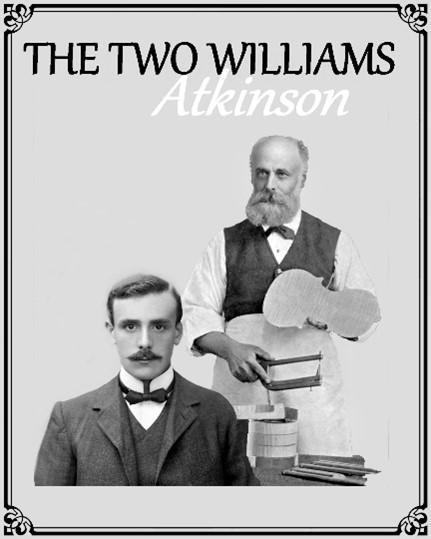Trade secrets taken to the grave…
Wandering down Church Road in Tottenham today, you might spot William Atkinson House, a 1970s sheltered housing complex. But who was William Atkinson and why is his name commemorated here?
William Thomas Reed Atkinson (1851 - 1929)
A Master Joiner and an important violin maker, William Senior’s work is celebrated as one of the best violin makers that this country has ever known.
In the early 1890s, William established a shop at 13 Church Road (now marked by a historical plaque on the former site of the shop). Here his violin creations flourished. At that time his income was enhanced by selling a wide range of hardware, including oils, brushes, varnishes, glues, felts and tar. At the end of the 19th century, his son, William Thomas Camper Atkinson, an apprentice carpenter and joiner, worked with him in the shop and they later formed a partnership.

(Photograph courtesy and © Andy and Peter Thomas)
William Senior dedicated a lot of time experimenting with varnishes. The varnish he found and used for the Atkinson violins was admired by many. In The Strad of 1893, William claimed he had solved the mystery of what had made the revered varnish used by 16th and 17th century Italian Master violin makers. Their varnish was warm in colour, clear and made the instrument last longer. Striving for the best varnish was a hot topic of discussion amongst violin makers – and William was no exception.
In 1928, William said:
‘If I were asked what was my greatest gift, I should say it was to make a violin, but I would not spend five minutes on it if I had not got the varnish I use. That varnish is my own, and I would stake my life it is the same varnish the old masters used.'
Sadly for Tottenham, by 1911 William Senior and his wife Mary had to move out of London to the countryside, settling in Paglesham in Essex. The early 1900s saw Tottenham’s air becoming more polluted, with more factories moving to Tottenham along with steam trains, population growth and coal fires, all playing their part. This contributed to spoiling the drying process of the varnish on the violins. William’s violins with their oil-based varnish took a long time to dry – and it was essential that the air was clean. In Church Road, his violins were hung outside in the yard. He could make a violin in a fortnight, but it took two years for the varnish to dry. A move to the countryside away from pollutants was essential to maintain the high standards in making his award-winning violins.
Trade secrets …
William continued making his violins in Paglesham but never revealed the secret recipe of his varnish. The Daily Express in 1929 reported William’s deathbed attempt: ‘The old man realised too late he was dying, and tried to impart the secret to his son, but the effort was too much for him. He fell back on his pillow dead.

(Photograph courtesy and © Andy and Peter Thomas)
One of his violins and parts from his workshop now form part of the collections at Bruce Castle Museum and Archive.
William Thomas Camper Atkinson (1883 – 1971)
William Junior was fascinated by photography and the improving techniques in taking photographs, especially out in the open air. Jobbing around his work as a Master Joiner, William enjoyed experimenting with his new craft and camera. His reputation grew in the local community as a photographer taking family portraits, weddings and scenes of the changing built environment around Edwardian Tottenham.

(Netta Powell, a Church Road neighbour of the Atkinsons, photographed by William Junior playing an Atkinson violin. Photograph courtesy and © Andy and Peter Thomas)
William’s portfolio was extensive, winning awards for his work. He left a lasting legacy with his collection of photographs, creating an important and extraordinary record of the local area in Tottenham in the early decades of the 20th century. His collections are lovingly cared for by his grandsons Peter and Andy Thomas, with a lovely small collection of his work also curated in Bruce Castle Museum and Archive.
Remembering the Two Williams
Both Williams left an exceptional legacy of craftmanship in violin making and photography. In the early 1970s, after the clearance of many houses along Church Road by the council, the sheltered housing complex in the new development (at the corner of Beaufoy Road and Church Road) was named after the violin maker William Atkinson.
The original shop at 13 Church Road had been demolished in the clearance of houses during the 1970s. In August 2021, a commemorative plaque to William Thomas Reed Atkinson the violin maker was unveiled by the Mayor of Haringey, Cllr Adam Jogee. Organised by two of his great-grandsons, Andy and Peter Thomas, the plaque marks the former site of the Atkinson shop at 13 Church Road, where so much craftmanship once excelled. Find out more about the plaque.

(The Mayor of Haringey Cllr Adam Jogee in August 2021 holding an Atkinson violin, owned by Andy Thomas, the great-grandson of William Thomas Reed Atkinson the violin maker. On the occasion of the unveiling of the plaque to William Atkinson on the site of his home and workshop at 13 Church Road, N17. Photograph courtesy and ©Andy Thomas)
William and Mary’s grave was refurbished by the Atkinson family in 2023. The grave honours their ancestor’s craft as a ‘luthier’ - a fitting memorial. The graves of both Williams can be found in Tottenham Cemetery.
Location
The Two Williams Atkinson
Beaufoy Road
Tottenham
N17 8AJ
United Kingdom